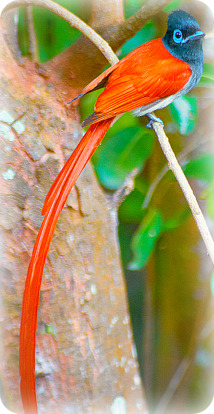UGANDA BIRDING SAFARI GUIDE
The African paradise flycatcher
If you are Planning a Uganda Birding Safari. Then plan to enjoy the African paradise flycatcher.
In this section of the Uganda Birding Safari Guide we share with you information about African paradise flycatchers that can help you enjoy your Bird watching tour to Africa.
You will find information about:
- where to find the African paradise flycatcher in Uganda
- How to Identify them and
- Some interesting facts about these Uganda Birds
where to find the African paradise flycatcher (Terpsiphone viridis)
The paradise-flycatchers are of two distinctive kingdoms with long rufous or white tails.
The African paradise flycatcher is a beautiful black-headed bird with two color morphs; white and rufous and many variations as well as hybrids with Red-bellied paradise flycatcher.
A black and white morph is common in some parts of Uganda especially Kibale forest and eastern part of the country but you can come across the Red –bellied paradise-flycatcher.
Characteristics of the African paradise flycatcher
The male bird is 36cm 14inch in height with a centre tail which is longer than the female.
Of the six occurring races, a typical rufous adult male has a slightly crested black or blue-black head merging into grey under parts while the mantle, wings and tail is white instead of chestnut.The adult female and immature birds resemble the rufous but have shorter tails.
In their habitats
You will find single birds or pairs common and widespread in open woodland, gardens and bushes or forests.
Their major food is mainly insects, flies, larvae particularly caterpillars.
African paradise-flycatchers have a loud scratchy, nasal and cheerful warbling which sometimes breaks into a rhythmical pi-pi-pi-pi-pi-pi-pi-pi-piiii.
They also have a common call which is abrupt zweet-zwat.
Return from The African Paradise-flycatcher to the index page of The Uganda Birding Safari Guide
Return to The Uganda Tourism Business Guide.



